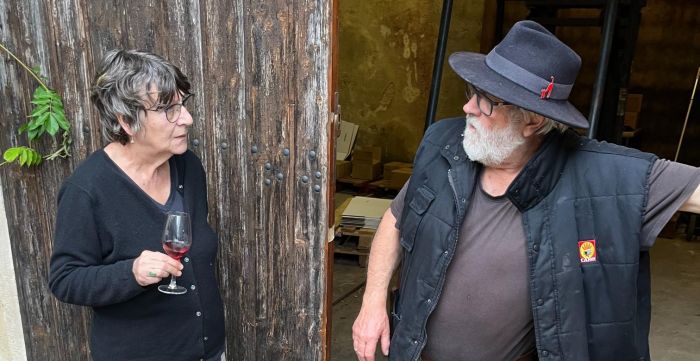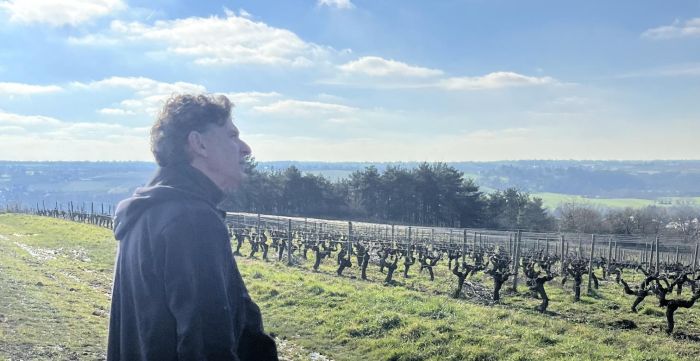Please wait ...

Articles
A Deeper Dive Into Yannick's Work Philosophies
A deeper dive into Yannick's work philosophies
Read more…Article
When I saw Alain Coudert from Clos de la Roilette’s calling my phone last Saturday morning, I didn’t pick up. It’s abnormal for a vigneron to call over the weekend in regards to business, but I figured he wanted to talk about an upcoming pickup, a label registration or something of the sort. I was also rammed in a car full of childhood friends road-tripping for the holiday weekend; I let the call go to voicemail, deciding to give Alain a ring when we got to our destination. Then came a text from my mother asking me to call her: that meant bad news. Four days later and I’m still shell-shocked over Julie’s passing. Having been at her house less than a month ago, Julie had exuded so much LIFE over the course of that evening that her disappearance still feels impossible.
Where do I start with Julie? The beginning? She started making wines under her own name in 2009, but had entered our collective orbit a few years prior. Her name was on everyone’s lips circa 2007 as the new talent to look out for. So Joe and Denyse decided they had to meet her, visiting Julie while she still ran the cellar at Terres des Chardons in the Costières de Nimes. An instant connection was made and it was agreed Louis/Dressner would import the wines. The following summer, Denyse remembers seeing Julie in the Beaujolais with Yvon Métras: she had visited the land that would become her Fleurie parcels (1) but nothing was finalized.
After securing the land in the Beaujolais and working it less than a full year, Louis/Dressner imported Julie’s first eponymous wines despite what felt like astronomical pricing at the time coupled with the complicated -now increasingly common- full-bodied nature of the solar 2009 vintage. I remember the first cuvées of 2009 "En Remont"(2) and “Vieilles Vignes” gathering dust on the shelf at Arlequin Wine Merchant where I worked in San Francisco. Beaujolais was having a moment around then, but that moment was intricately linked to cheaper pricing and the distinctly crystalline, semi-carbonic “light” style the region was known for. Actually, critics loved the 2009 vintage, they felt it was an achievement to have produced such ripe, big wines. We felt it was a pity that a wine we loved for its lightness and freshness was evaluated through the wrong criteria: it was not a vintage of our liking.
LDM pressed on with the fantastic 2010’s, and by 2011 -the first of many vintages Julie felt obliged to blend her cuvées into a one-off wine, in this case “Carioca”(3)- a fanaticism of sorts was building around her. Julie’s star would continue to rise, and by the mid 2010’s she had earned her rank as a cult producer amongst a small but dedicated subset of drinkers. Usually I don't care about this type of thing much, but with Julie's wines I began to notice something different. It seemed like savvy drinkers understood and valued her efforts and vision, could TASTE it.
As far as I’m concerned, Julie was instrumental in fomenting a paradigm shift in how natural wine is approached. Producers like Julie forced companies like ours to re-align our values on, well, value. Louis/Dressner has always been about the underdog: independent vignerons from small or unknown regions making real, honest wine. For most of the company’s existence, that usually meant a “bang for your buck” due to the producer and/or region’s lack of notoriety. But vigneronnes like Julie Balagny changed the tide: value didn’t have to be economically tied to a famous region or a famous vigneron anymore, but to the VALUE of hard work, of vision, passion and qualities bordering on artistic expression. More often than not, these producers were outsiders to the region they made wine in: second-career “neo-vignerons/vigneronnes” working hyper-artisanally (in Julie’s case with zero mechanization) with no employees, requiring countless hours more work in the vines and cellar.
There were of course precursors to Julie. But her arrival on the scene at the dawn of the information era, a time when consumers could meticulously geek out on every aspect of a vigneron’s work, was serendipitous and integral in getting a lot of people hooked on seeking out similar wines.
I guess what I’m trying to say is that a lot of what we do now, or at least the way I interpret what we do, goes back to representing a human’s passion and humanity through their wine. Is this something we can actually succeed in as a company? Knowing Julie so well, I could taste the good, the bad, the chaos, the laughs, the bare-bones EVERYTHING, the pseudo-commune that was her house, even her crazy dogs, chickens and sheep running around the yard and vineyards... Are these things someone who's never met her can taste? I don't know, but I'd posit that this type of je ne sais quoi is what drew so many to seek out her cuvées in the first place. Julie made me look for these qualities in other producers, seek them out even.
Ok, I’ve been going on for a while now and barely broached Julie as a person. What can I say, Julie Balagny was one of a kind, always marching to the beat of her own polyrhythmic drum. Born in an aristocratic, well off Parisian family, she eschewed modern life and luxury for peasantry, the country-side, farm work. She lived a bare-bones, rustic and quasi-off the grid lifestyle. She was constantly brimming with restless energy and ideas. She lived in total chaos, and more then once the hectic energy she emitted and surrounded herself with made me feel like the mark of a prank tv-show or like I was making a cameo in a bizarro episode of the Beaujolais Real World (4).
The wackiness really ramped up when Julie moved to Romanèche-Thorins in 2015. Prior to living there, our visits with her tended to be one-on-one, more classic: a meet and greet, a tour of the vines, tasting wines in the cellar then a dinner somewhere. But, with the exception of summer 2015 when we visited her newly acquired Beaujolais and Moulin-à-Vent plots (5), all visits to the Romanèche house meant being SUCKED INTO THE VORTEX. There were of course the aforementioned dogs, chickens and sheep freely roaming the yard, often driving my mother's dog Zaggy completely bonkers (6). More memorable were the ever-revolving cast of employees, seasonal workers, friends, weirdos and wasteoids that became the de-facto accompaniment to our visits. If you’d entered that courtyard enough times (7), you knew you were going to be talking to chain-smoking randos knocking back glass after glass of Gamay (8).
And of course there was always Julie, presiding over the chaos like nothing could be more normal. Cheeks red, hair blonde, eyes blazing blue and smiling at you like the lost long friend she hasn't seen in ages. Within minutes, you’d be deep in a conversation that would go on for hours, constantly re-enforced with another bottle, countless rolled cigarettes and, only after I insisted and because time had gotten away from her, a haphazard, improvised meal thrown together hours later than it should have been (9).
There was always a lot to talk about. The usual vigneron blah blah (the weather, the vintage...) was only a formality with Julie, a quick box to check off so we could get to the good stuff. Sometimes it was hard to focus on her because a sheep was bumping its head into your leg. Or a very intoxicated shirtless man, badly scraped and bruised from drunkenly crashing his scooter hours earlier was berating you for not wearing a face-mask when bicycling in New York City (he'd never been and this was pre-pandemic). Or an equally intoxicated sommelier rolling in the dirt telling a sheep he loved them. Or an even more intoxicated sommelier drunkenly cutting up cucumbers and tomatoes, putting them in his glass, pouring and drinking a Balagny wine in it before I confiscated it (ok, that was the same sommelier telling the sheep he loved it, here is his picture).

Julie's house could sometimes feel like a haven for lost souls. Yet just as often you’d feel a raw energy, an incubator for a new generation of rural youth forging their own path. In both cases, it came from a place of utmost generosity and open-mindedness on Julie’s part. Most of the people I met at her table found inspiration working with her, whether there for seasonal work or deciding they wanted to become a vigneron in their early 50's and randomly apprenticing with her knowing nothing about natural wine. For the full-time crew, itself a rag-tag group of misfits, there was a feeling of belonging, a leftist, ecologically militant oasis in an increasingly far-right and angry rural France.
The most recurrent character in the last few years, one whom I’ve grown to adore, is Sylvain Chanudet, an ex-vigneron and the personified quintessence of a Beaujolois. After a very complicated period in his life, Julie had let Sylvain stay with her for a bit. He never left, becoming a permanent house-mate, adviser, pro-bono employee and even selling Julie some of the grapes he continues to meticulously farm despite not making wine anymore. Over the last few years, a visit with Julie meant a visit with Sylvain, always a treat for me. Their bond and friendship was so clear, so deep and powerful. I can’t imagine how much pain he must be in right now.
My last visit with Julie was less than a month ago, on Thursday June 8th. I got to the house around 6pm: after accidentally startling Julie who hadn’t heard me come in, a group of three young men arrived and quickly hunkered around the outdoor table to smoke cigarettes and drink Gamay. These were Julie’s employees, including Brice aka Docteur Briçou (you may recognize that name from the Moulin-à-Vent cuvée (10)) and two other guys whose name I didn’t catch. They were looking at how to manually fix a part of a 1970’s chariot the team use to till the vines; replacement parts haven’t been available to purchase for roughly 45 years. At some point a young woman swung by for no perceptible reason (though I have a hunch), had a few glasses and cigarettes and left.
Julie and I then tasted a recently bottled 2022 called "François", of which she gave me the back story. In 2020, she’d made a one-off wine called “Françoise” (11) from a plot of Beaujolais fruit her friend ended up still having when a contract didn’t go through at the last minute. In 2022, a young vigneron had committed suicide just before the harvest and his family was looking to sell the grapes. Julie felt it would have been wrong to call them herself (she didn’t want to take advantage of a terrible situation), but when it was them who reached out she decided to buy some. Julie named the cuvée "François" (12) and asked her label artist Delphine to make a man bringing flowers to his Françoise. Two one-offs loaded with symbolism.
We then tried various 2022’s from barrels, some of which had tangible amounts of sugar that still needed to ferment, others that were to be bottled soon (I am unaware if this occurred in the time between my visit and her passing). When we re-emerged from the cellar, Sylvain Chanudet and Tristesse, an older shirtless man who seemed very smily for having the nickname “sadness” (probably the point) had joined the other employees for some smokes and wine before they all headed off to get more work done in the vines.
That left Julie and I. Incredibly, this was destined to be our one and only tête à tête conversation in over a decade of friendship. Without the clique, we talked undistracted for hours-over a few bottles of course. She brought me up to speed with the craziness of dealing with her father’s inheritance and what it meant for the future of the estate. How she was planning on expanding her négociant line with grapes from Sylvain to help her have some earlier releases and keep things financially afloat. How she loved my “Sons of Winearchy” t-shirt (13) and wanted me get her one. We dove into her utopian vision of work and what she still hoped to accomplish: a true symbiosis of nature, beast and man coexisting and taking care of one another. I didn’t take very many notes but here are two quotes from that conversation:
"I work on a human scale with human beings."
"We're not business people, we're ecologists.”
She talked about giving her employees a chance to make their own wines while still having the security of employment with her, to encourage them to work well and to know they have a support system. In fact, her long-term goal was to create a cave cooperative with her employees, Sylvain Chanudet and a few other vignerons: sharing equipment, helping each other with manual labor, building a communal cellar so smaller upstarts wouldn't have to take on the financial pressure of building their own cellars… Going back to older pieces I’d written about her, Julie was saying much of the same over a decade ago in January 2012:
“I think it will remain as is in size. As I mentioned earlier, the real evolution I hope to achieve will come from working with livestock and the woods. If there were to be an expansion, I'd rather do it to help a young vigneron get started. There would be room to assist each other, to share tools, know-how and manual labor.”
From this conversation, it finally clicked as to why Julie constantly surrounded herself with all these people, why she was so zen with her open door policy. Anyone and everyone was welcome. This wasn’t because of boredom or loneliness, this was a vision, a way to live… A true cooperative space where anyone was welcome!
Finally, we talked about how she was feeling great overall, how she was really embracing and enjoying life in her 40’s and that it was something I should look forward to. Putain…
As the sun was setting, some of the guys came back, including Sylvain with a bunch of goat cheese from Tristesse’s friend. The other guys left; Sylvain had eaten already but kept us company while Julie prepared a quick meal: salad and cherries from her garden, potted Poulet en Crème and Tristesse’s goat cheese. On the cheese, Sylvain had this to say:
“All I need is some of this, a piece of saucisson and a glass of Gamay in the morning. I’m good to go”.
The three of us talked for many more hours: about the state of the world, about the Beaujolais, about a bunch of shit that would be too long to transcribe here. Julie started putting on music, which led us listening to Suprême N.T.M (a french rap crew) (14) and N.W.A , leading a philosophical discussion of how rap lyrics gave a voice to the oppressed, a way to speak truth to the injustices inflicted upon them. Sylvain admitted it wasn't really his thing sonically; he preferred Toto (15), whom he’d seen live in the 80’s and who he felt were very talented musicians. At some point a Mozart sonata came on. Chaos!
Before leaving, Julie gave me a picnic basket full of breakfast goodies and an unlabeled magnum for Kewin Descombes’ 10 year anniversary party (16), which I drank with Jules Métras, Elisa Guerrin, Laura Lardy and a young woman from California apprenticing at Domaine Chapel who was hoping to visit Julie at some point. As I was about to drive off, Julie called for me in the night, running towards the car to hand me the notebook I’d forgotten at the table. It was the last time I’d see her.
That night, I felt like we were on the verge of something. Like any truly amazing conversation, it can feel like you’ve figured everything out, that your ideas can change the world. Julie was radiant with joy and energy, smiling, laughing, cheering us on. We did the same. At one point I felt the presence of my usual Beaujolais companion Denyse (aka my mom) and my deceased father at the table with us, smiling fondly on these three individuals from wildly different backgrounds united over good wine and good people. I got emotional. I told myself: “this is why we fucking do what we do.” It was by far the best visit I’d ever had with Julie; she seemed at the apex of what she was doing, ready to push things to a whole other level. On my end, I left invigorated and re-inspired for the future: my own, my company’s, Julie’s. The visit felt like a gift, a sign of great things to come. Yet just a few weeks later I find myself forced to re-interpret those feelings.
The magic of Julie Balagny can never be emulated or recreated. She was amongst a small group of vignerons/vigneronnes I truly idolize for their eclecticism, irreverence, passion, energy, idiosyncrasy and conviction. Julie forged a community around her, one we’re all so much better off for having been a part of. I won’t try to find a replacement for Julie; instead I’ll look out for those same qualities in those I choose to surround myself with.
Because people like her CAN change the world.
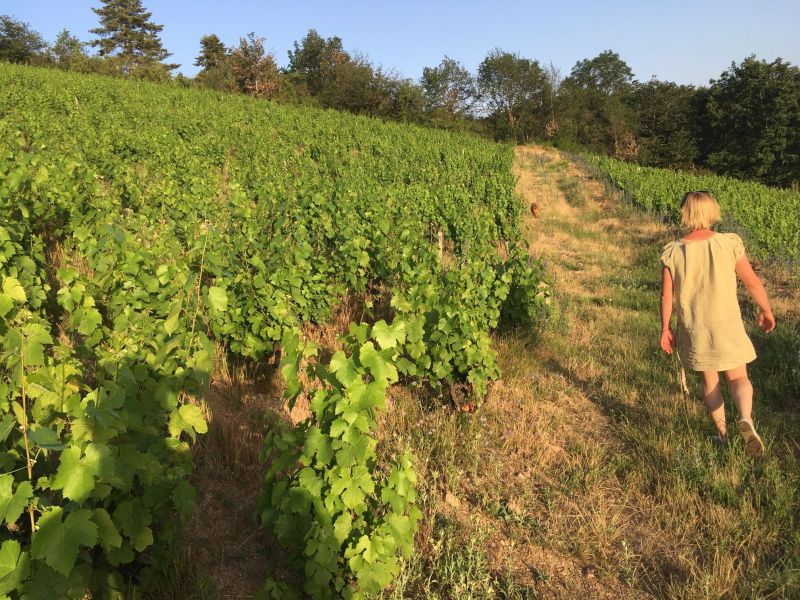
***********
(1): Julie in her Fleurie vines with Trevor Kellogg in 2019.

(2): a scan of the "En Remont" 2009 label.
 .
.
(3) The Carioca 2011 label.

(4): Christmas in summer at Julie Balagny's. Notice all the bottles on the table.

(5): Julie in her Moulin-à-Vent vines, 2015.
(6) Dogs and sheep driving Zag bonkers.
(7): The front yard in Romanèche-Thorins

(8): Rolling tobacco and Gamay, staples at Julie's table. Notice the Che Guevara tobacco pouch.

(9): My last haphazard meal with Julie, 2023.

(10) The Docteur Briçou label
 (11) "Françoise", a one-off cuvée made in 2020 from purchased fruit.
(11) "Françoise", a one-off cuvée made in 2020 from purchased fruit.

(12) "François" a one-off cuvée and the only 2022 bottled at the time of my visit. the spiritual succesor to "Françoise".

(13): The Sons of Winearchy designed for our 2015 trade tasting t-shirts.

(14): The music video for Suprême N.T.M's "Laisse Pas Trainer Ton Fils", the song we listened to and one of the best songs in the history of French hip-hop.
(15) Toto: they saw the rain down in Africa. Here is a nine minute remix I've been using as a secret weapon in DJ sets for years:
(16): Beaujolais Breakfast.
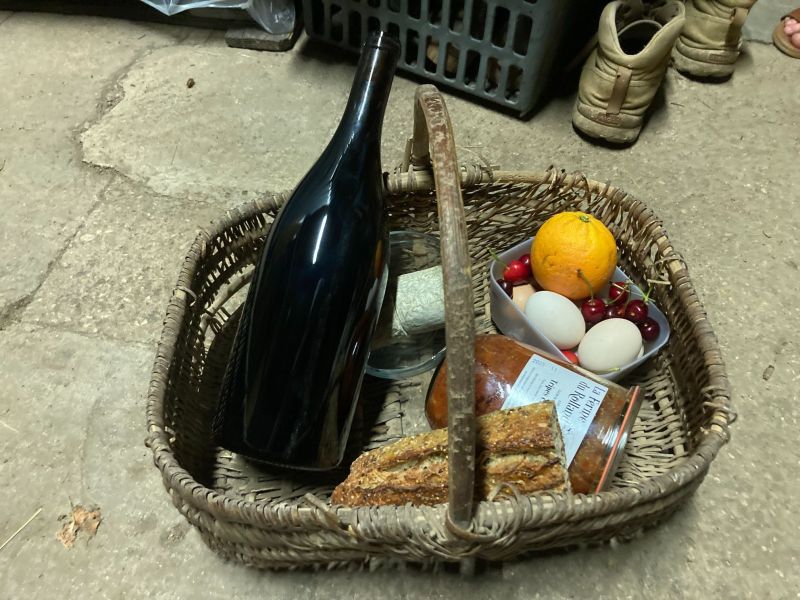
(MISC): A pair of Converse gifted to Julie in 2021. It became a running gag that we secured our annual allocation of her wines by bringing her a pair, as they are much cheaper in the United States.

(MISC): Julie driving us to her Fleurie parcels in 2019.

(MISC): a whirlwind of dogs and sheep encircling Denyse Louis in 2015.
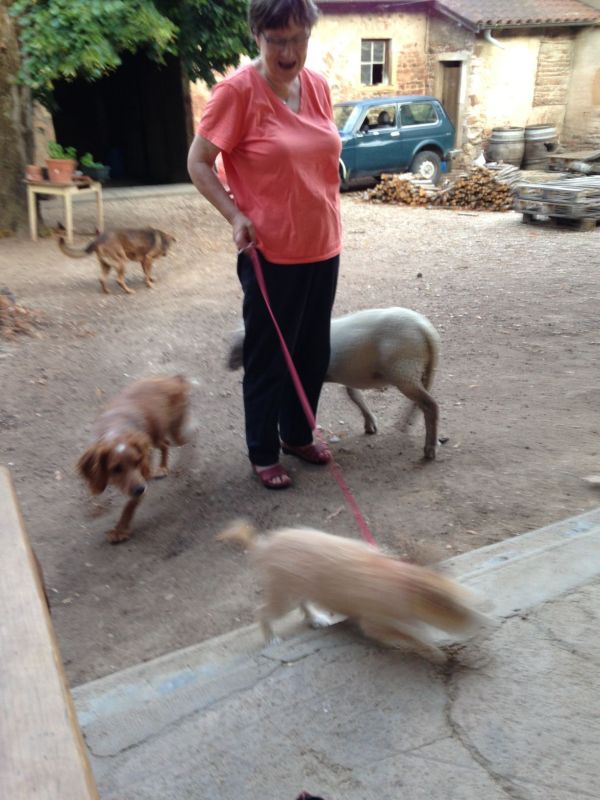
(MISC): The label for the 2017 one-off "Docteur Buchaille Présente Ordinaire". That vintage, Julie's microscopic yields forced her to blend her Moulin-à-Vent grapes with her Beaujolais grapes. Inspired by her amazing time in California following her invite to Brumaire in Oakland, she decided to immortalize this mashup by naming the cuvée after the Oakland wine bar Ordinaire (the joke being that it is anything but ordinary). She also included the whale tattoo Ordinaire owner Bradford Taylor has and Keven Clancy, our partner and friend at Farm Wine Imports, front and center of the label (that's him with the glasses).

(MISC): Le label for "Bella Ciao", the other 2017 cuvée in which Julie blended all of her Fleurie fruit into one wine.
From wikipedia: "Bella ciao" is an Italian protest folk song from the late 19th century, originally sung by the mondina workers in protest against the harsh working conditions in the paddy fields of Northern Italy.
It is widely assumed that the mondina song was modified and adopted as an anthem of the Italian resistance movement by the partisans who opposed Nazism and fascism, and fought against the occupying forces of Nazi Germany, who were allied with the fascist and collaborationist Italian Social Republic between 1943 and 1945 during the Italian Civil War. However, historians argue that there is little to no evidence that Italian partisans actually sang the song.
Versions of "Bella ciao" continue to be sung worldwide as a hymn of freedom and resistance.

(MISC): a video I recorded of Julie grabbing a salad in her backyard for our last dinner. I posted it on social media, to which she responded: Ainsi va la Vie!" ("such is life!")



